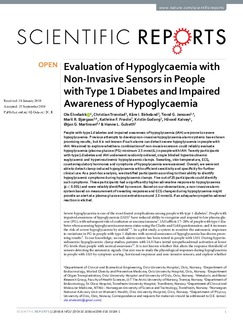| dc.contributor.author | Elvebakk, Ole | |
| dc.contributor.author | Tronstad, Christian | |
| dc.contributor.author | Birkeland, Kåre I. | |
| dc.contributor.author | Jenssen, Trond Geir | |
| dc.contributor.author | Bjørgaas, Marit Ragnhild Rokne | |
| dc.contributor.author | Frøslie, Kathrine Frey | |
| dc.contributor.author | Godang, Kristin | |
| dc.contributor.author | Kalvøy, Håvard | |
| dc.contributor.author | Martinsen, Ørjan Grøttem | |
| dc.contributor.author | Gulseth, Hanne Løvdal | |
| dc.date.accessioned | 2019-01-29T13:53:14Z | |
| dc.date.available | 2019-01-29T13:53:14Z | |
| dc.date.created | 2018-10-24T11:44:51Z | |
| dc.date.issued | 2018 | |
| dc.identifier.citation | Scientific Reports. 2018, 8:14722 1-11. | nb_NO |
| dc.identifier.issn | 2045-2322 | |
| dc.identifier.uri | http://hdl.handle.net/11250/2582882 | |
| dc.description.abstract | People with type 1 diabetes and impaired awareness of hypoglycaemia (IAH) are prone to severe hypoglycaemia. Previous attempts to develop non-invasive hypoglycaemia alarm systems have shown promising results, but it is not known if such alarms can detect severe hypoglycaemia in people with IAH. We aimed to explore whether a combination of non-invasive sensors could reliably evaluate hypoglycaemia (plasma glucose (PG) minimum 2.5 mmol/L) in people with IAH. Twenty participants with type 1 diabetes and IAH underwent randomly ordered, single blinded hyperinsulinemic euglycaemic and hyperinsulinemic hypoglycaemic clamps. Sweating, skin temperature, ECG, counterregulatory hormones and symptoms of hypoglycaemia were assessed. Overall, we were not able to detect clamp-induced hypoglycaemia with sufficient sensitivity and specificity for further clinical use. As a post-hoc analysis, we stratified participants according to their ability to identify hypoglycaemic symptoms during hypoglycaemic clamps. Five out of 20 participants could identify such symptoms. These participants had a significantly higher adrenaline response to hypoglycaemia (p < 0.001) and were reliably identified by sensors. Based on our observations, a non-invasive alarm system based on measurement of sweating responses and ECG changes during hypoglycaemia might provide an alert at a plasma glucose concentration around 2.5 mmol/L if an adequate sympatho-adrenal reaction is elicited. | nb_NO |
| dc.language.iso | eng | nb_NO |
| dc.publisher | Nature Research | nb_NO |
| dc.rights | Navngivelse 4.0 Internasjonal | * |
| dc.rights.uri | http://creativecommons.org/licenses/by/4.0/deed.no | * |
| dc.title | Evaluation of hypoglycaemia with non-invasive sensors in people with type 1 diabetes and impaired awareness of hypoglycaemia | nb_NO |
| dc.title.alternative | Evaluation of hypoglycaemia with non-invasive sensors in people with type 1 diabetes and impaired awareness of hypoglycaemia | nb_NO |
| dc.type | Journal article | nb_NO |
| dc.type | Peer reviewed | nb_NO |
| dc.description.version | publishedVersion | nb_NO |
| dc.source.pagenumber | 1-11 | nb_NO |
| dc.source.volume | 8:14722 | nb_NO |
| dc.source.journal | Scientific Reports | nb_NO |
| dc.identifier.doi | 10.1038/s41598-018-33189-1 | |
| dc.identifier.cristin | 1623045 | |
| dc.description.localcode | © The Author(s) 2018. This article is licensed under a Creative Commons Attribution 4.0 International License. | nb_NO |
| cristin.unitcode | 194,65,15,0 | |
| cristin.unitname | Institutt for klinisk og molekylær medisin | |
| cristin.ispublished | true | |
| cristin.fulltext | original | |
| cristin.qualitycode | 1 | |

